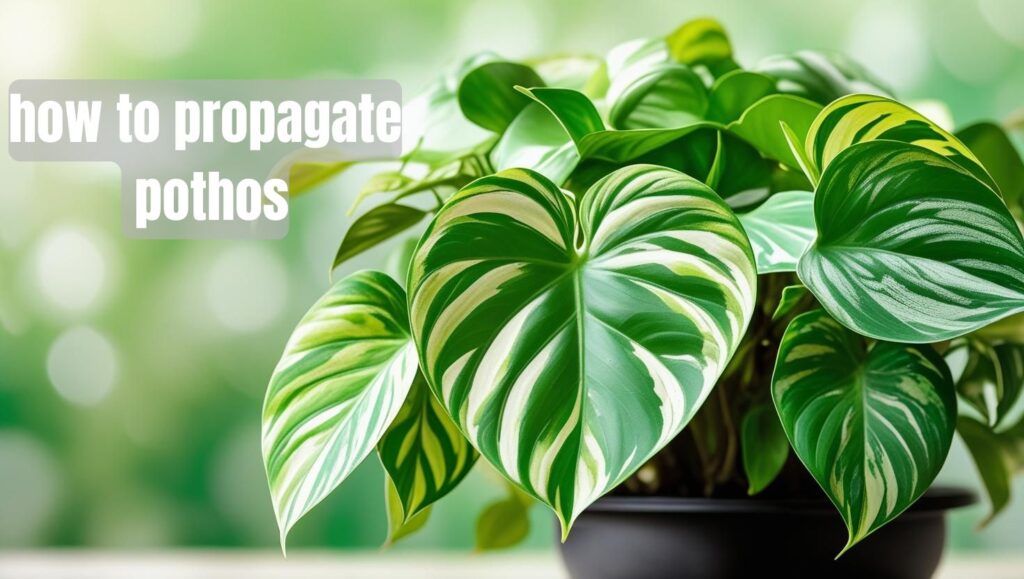How to Propagate Pothos: A Step-by-Step Guide
Pothos (Epipremnum aureum) is one of the most popular and beginner-friendly houseplants, known for its beautiful trailing vines and ease of care. Whether you’re a seasoned plant enthusiast or just starting your indoor gardening journey, learning how to propagate pothos is a rewarding and budget-friendly way to expand your plant collection.
Propagation not only helps you grow new plants for free but also allows you to share greenery with friends and family. In this step-by-step guide, we’ll walk you through the entire process of propagating pothos—from selecting a healthy vine to rooting it successfully in water or soil.
You’ll also learn how to care for new cuttings and troubleshoot common problems like root rot or slow growth. By the end, you’ll have everything you need to confidently grow your own lush pothos jungle. Let’s get started on multiplying your favorite plant the easy way!
Why Propagate Pothos?
- Easy for beginners
- Fast-growing roots
- Helps rejuvenate leggy vines
- Great for gifting or expanding your indoor jungle

Tools You’ll Need
- Clean, sharp scissors or pruning shears
- A glass jar or small vase
- Fresh, room-temperature water
- Optional: rooting hormone (for faster growth)
- A healthy parent pothos plant
Step-by-Step Propagation Instructions
Step 1: Identify a Healthy Vine
Look for a vine that is long, healthy, and has multiple leaves. Choose one with visible nodes (small bumps opposite the leaves), as roots will grow from these nodes.
Step 2: Cut Below a Node
Make a cut about 1/4 inch below a node using clean shears. Ensure each cutting has 3–4 leaves and at least one healthy node.
Step 3: Remove Lower Leaves
Remove any leaves that will be submerged in water to prevent rot. Keep only the top leaves intact.
Step 4: Place in Water
Place the cutting in a clear jar of water with the node submerged. Keep the jar in a warm spot with bright, indirect light.
Step 5: Change Water Regularly
Change the water every 3–5 days to keep it fresh and oxygen-rich. This prevents bacteria buildup and encourages healthy root growth.
Step 6: Wait for Roots to Grow
Roots usually appear within 1–2 weeks. Let them grow to 2–3 inches before transplanting into soil.
Step 7: Pot Your New Pothos
Once roots are long enough, plant the cutting in a pot with well-draining indoor plant soil. Water thoroughly after planting.

READ ALSO: Foodscaping Made Easy: How to Turn Your Front Yard into a Beautiful, Edible Garden
Popular Pothos Varieties
- Golden Pothos
- Green leaves with golden-yellow variegation.
- Most common and beginner-friendly.
- Green leaves with golden-yellow variegation.
- Marble Queen Pothos
- Creamy white and green marbled leaves.
- Needs bright light to maintain variegation.
- Creamy white and green marbled leaves.
- Jade Pothos
- Solid dark green leaves.
- Great for low-light areas.
- Solid dark green leaves.
- Neon Pothos
- Bright chartreuse or neon-green leaves.
- Adds a vibrant pop of color indoors.
- Bright chartreuse or neon-green leaves.
- Pearls and Jade Pothos
- Small leaves with white, gray, and green variegation.
- Compact and slow-growing.
- Small leaves with white, gray, and green variegation.
- Manjula Pothos
- Broad leaves with white, silver, cream, and green swirls.
- A patented variety by the University of Florida.
- Broad leaves with white, silver, cream, and green swirls.
- Cebu Blue Pothos (Epipremnum pinnatum)
- Distinct silvery-blue leaves with a narrow, pointed shape.
- Not technically an aureum, but closely related.
- Distinct silvery-blue leaves with a narrow, pointed shape.
- Glacier Pothos
- Small leaves with icy green and white variegation.
- Ideal for tabletop pots.
- Small leaves with icy green and white variegation.
- Snow Queen Pothos
- Similar to Marble Queen, but with more white than green.
- Needs bright light to stay vibrant.
- Similar to Marble Queen, but with more white than green.
- Satin Pothos (Scindapsus pictus)
- Often mistaken for pothos. Velvety leaves with silver spots.
- Technically a different genus but cared for similarly.

Tips for Success
- Use filtered or dechlorinated water
- Keep cuttings warm (65°F–85°F)
- Use multiple cuttings in one pot for a fuller plant
- Be patient—some cuttings root faster than others
Frequently Asked Questions
Q1. What is the easiest way to propagate pothos?
A: The easiest way to propagate pothos is by water propagation. Simply cut a healthy stem below a node, place it in a glass of water, and wait for roots to grow.
Q2. How long does it take for pothos cuttings to root in water?
A: Pothos cuttings typically develop roots within 7–14 days when placed in clean, room-temperature water.
Q3. Can pothos grow in water forever?
A: Yes, pothos can survive in water indefinitely, but for optimal growth, it’s recommended to eventually transplant them into soil.
Q4. Should pothos cuttings be placed in sunlight while propagating?
A: Yes, place the cuttings in bright, indirect sunlight. Direct sunlight can damage the leaves, while too little light can slow root development.
Q5. Do I need to use rooting hormone to propagate pothos?
A: Rooting hormone is not necessary for pothos propagation, but it can speed up the rooting process if used.
Q6. How do I know when it’s time to transfer pothos from water to soil?
A: Once the roots are at least 2–3 inches long, your pothos are ready to be planted in soil.
Q7. Why are my pothos cuttings rotting in water?
A: Rotting occurs due to stagnant water or placing the cuttings too deep. Change the water every 3–5 days and ensure only the nodes are submerged.
Q8. Can I propagate pothos in soil directly?
A: Yes, pothos can be propagated directly in soil. Keep the soil moist and humid until the roots establish.
Q9. How many nodes should I include in my pothos cutting?
A: Include at least 1–2 nodes in your cutting. Each node has the potential to grow new roots.
Q10. Can I propagate pothos from just a leaf?
A: No, a leaf alone won’t grow roots. You need a stem cutting with at least one node for successful propagation.
Conclusion
Propagating pothos is one of the most rewarding ways to expand your indoor garden. With just a little time and care, you can turn a single vine into multiple thriving plants. Perfect for beginners and satisfying for seasoned plant parents, pothos propagation is a must-try plant project. Happy growing up!

